Visiting Monet's Garden in Giverny: My Top Tips For A Perfect Day Out
Explore Monet's colourful garden and peaceful home in Giverny, the place that inspired his iconic Water Lilies series.

Is Monet’s Garden in Giverny really worth visiting?
Yes — but the experience depends heavily on when and how you go. Crowds, seasonality, and timing can completely change how enjoyable the visit feels. Many visitors arrive at the wrong moment or rush through the gardens. This guide focuses on how to plan your day properly, what most people underestimate, and how to experience Monet’s garden at its most peaceful and memorable.
If you're looking for day trips from Paris, I can't recommend Monet's Garden in Giverny enough. It's every bit as dreamy as you'd hope. This is very spot where Claude Monet lived, painted, and found endless inspiration. Walking through his gardens feels like stepping right into one of his masterpieces.
The garden is stunning in every season, but if you want to catch it at its most iconic, try visiting between July - August when the famous water lilies are in full bloom.
To help you get the most out of your trip, I've pulled together some useful tips based on my own visit, plus a few things I wish I'd known beforehand. Whether you love art, flowers, or just dreaming of a peaceful escape from the city, Monet's Garden in Giverny is one of the loveliest places you can visit in Normandy - and in all France.
Bookings: Some of the links in this post are affiliate links. This means that if you decide to book through them, I may receive a small commission - at no extra cost to you. Thank you for your support!
Top Tips For Visiting Monet's Garden in Giverny
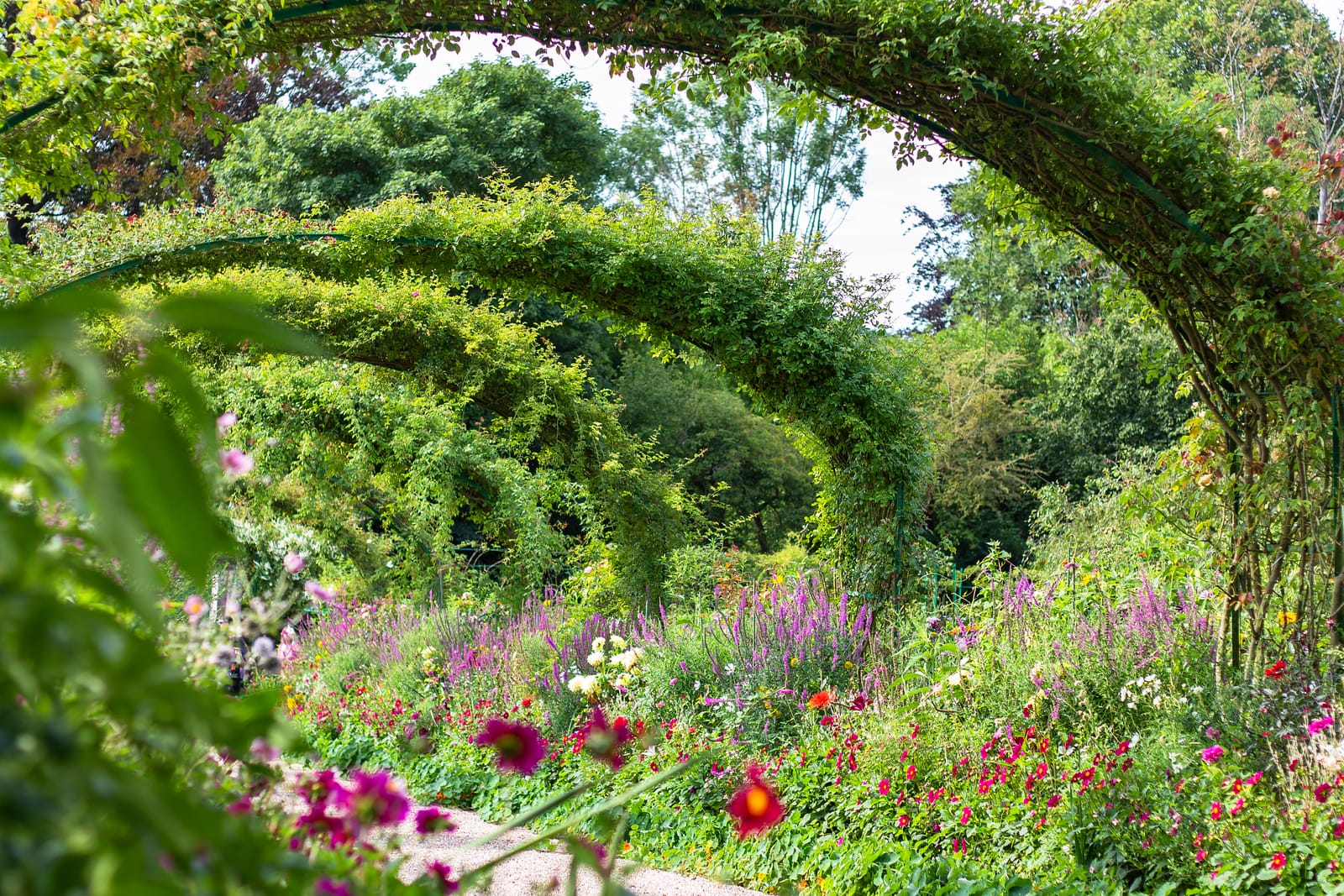
Visiting Monet's Garden and House was genuinely one of the highlights of our trip through Normandy - it's easy to see why it draws so many visitors. To help you make the most of your time there, here are my top tips from experience, so you can enjoy it as mush as we did.
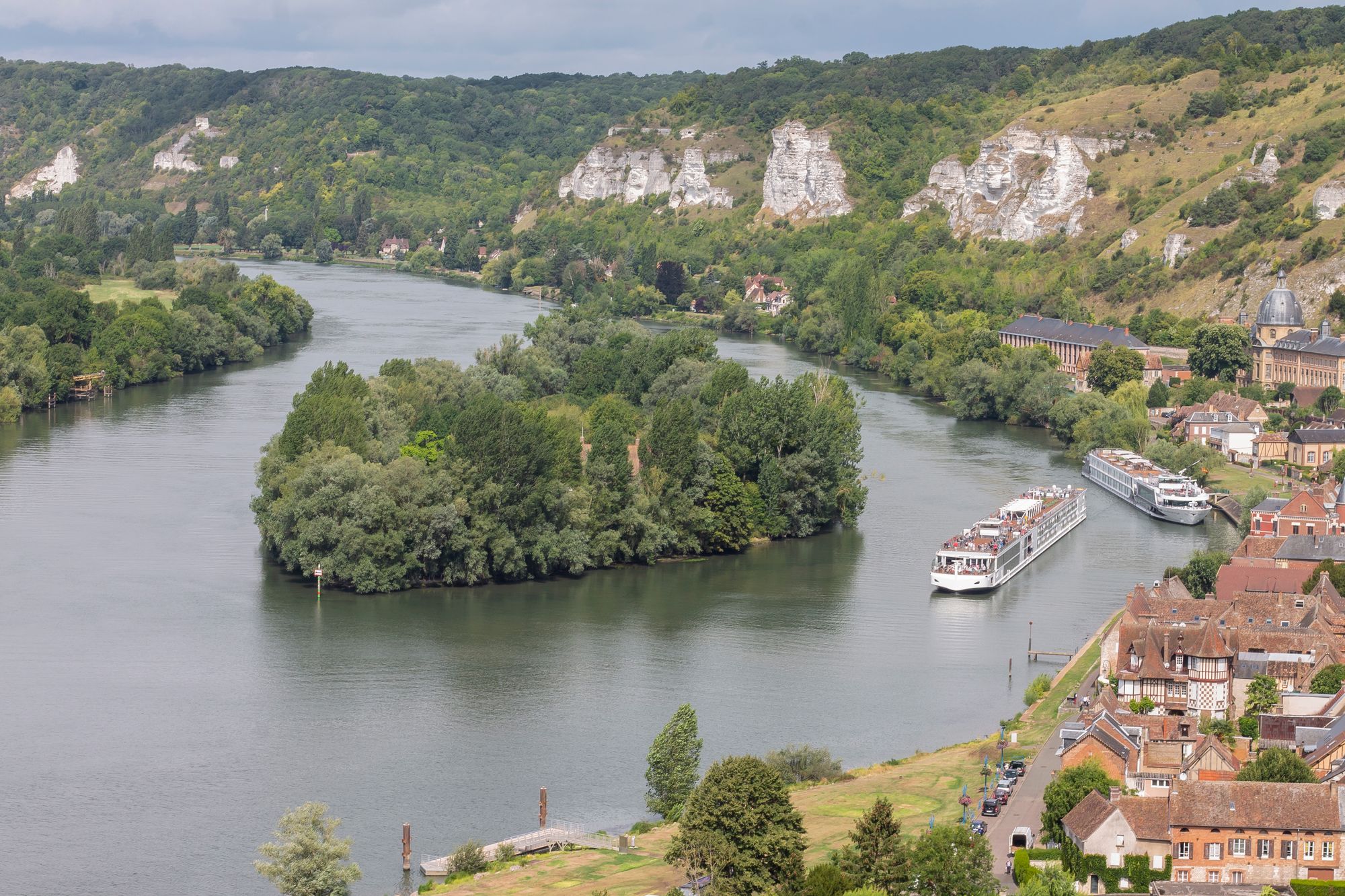
Arrive in Giverny the Night Before
Monet's Garden is one of the most popular attractions in Normandy (second only to Mont-Saint-Michel), so it can get quite busy during the day. To beat the crowds and soak in the magic, I'd recommend staying overnight in or near the lovely village of Giverny
The town itself is a delight - full of charm and character. Spend a day wandering through local art galleries, including the excellent Musée des Impressionnismes Giverny (Museum of Impressionism), and take your pick from cafes and restaurants scattered around the village.
In the early evening, once the day-trippers have gone, it's the perfect time for a peaceful stroll along Rue Claude Monet - the street named after the painter himself.
If you're up for a glass of wine or a relaxed dinner, a few of the restaurants stay open late. And before heading to bed, it's worth checking out where the queue forms in the morning - that way, you'll be ready to go without any hassle.
Don't miss Monet's Final Resting Place
While you're in Giverny, take a quiet moment to visit the Église Sainte-Radegonde de Giverny - a small church with a cemetery just a short walk from the garden. This is where Claude Monet is buried, along several members of his family. His grave is the third one from the right, marked with a white cross.
There's also a touching memorial nearby to seven British airmen who tragically lost their lives when their plane was shot down on the day after D-Day, crashing not far from River Seine.
Top Tip for Campervan Travellers: If you're exploring Normandy in a campervan, you're in luck. There's a spacious Aire (a French motorhome stop) just across the road from Monet's Garden. During the day it can be quite lively, but it quiets down at night. It's an ideal place to park up for the night and have a stroll around around Giverny after the garden has closed for the day.
Time Your Visit Right
Monet's Garden is busy at springtime - especially in May - and during the height of summer. If you're hoping to avoid large crowds, it's worth planning your visit just outside the peak months. We went in late August and found it still lively, but far less hectic - a perfect balance.
Try to arrive as early as you can. Mornings are generally much quieter, and we always find morning are a much more relaxed time to visit places like this.
As for how long to stay, give yourself at least two to three hours to explore both the house and gardens properly. There's more to see than you might think.
Book a Guided Tour or Skip-the-Line Ticket
One of the easiest ways to avoid the long queues at Monet's Garden is to book a skip-the-line ticket in advance. It makes your day so much smoother - and if you go for a guided tour, you'll also get loads of insight into the history of the garden, Monet's house, and the Giverny.
If you prefer exploring on your own, standard entry tickets usually cost around €12-€14 per person, depending on where you book. You can easily buy your Monet's garden tickets online via the Foundation Claude Monet website.
If you're short on time or not keen on driving or taking the train, there are also organised day trips from Paris that include both Versailles and Monet's Garden. It's a lovely option if you want to see the highlights without the hassle of planning everything yourself.
Pop Into Vernon on the Way to Giverny
If you've got a bit of extra time on your way to Giverny, it's worth making a quick detour to nearby town of Vernon. It's a lovely little place with a few gems to explore - including Monet's favourite spots in the area.
One of the highlights is the picturesque Old Mill, a restored mediaeval building that sits right above the Seine River. It was badly damaged during WWII, but has since been lovingly restored by the local residents.
The Old Mill has inspired many artists over the years, including Monet who captured it in his 1883 painting 'Houses on the Old Bridge at Vernon.'
Stop at Château Gaillard
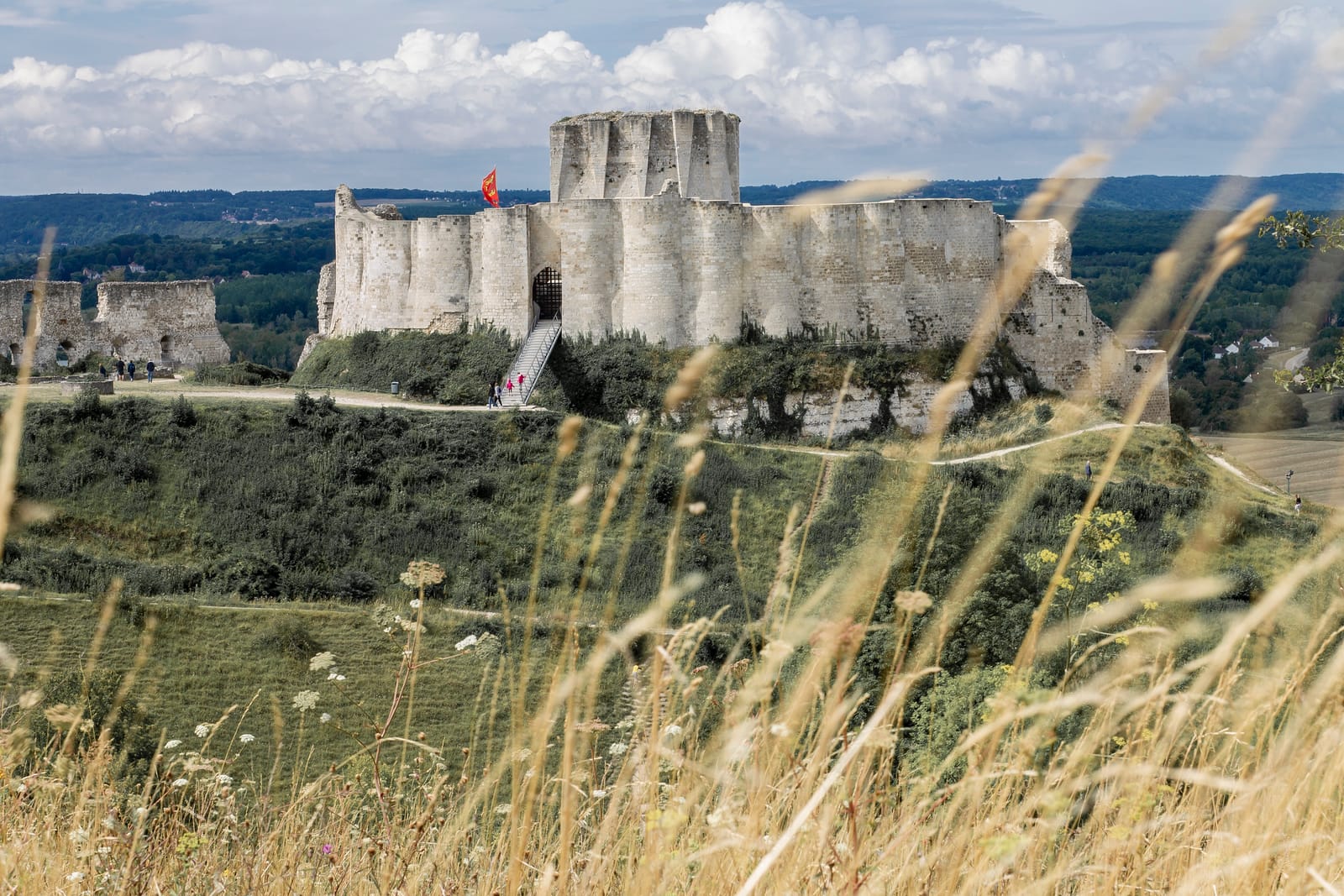
Not far from Giverny, the town of Les Andelys is another charming destination worth visiting. Perched high on a hilltop above the Seine, Château Gaillard is the star of the show here, and honestly, the views along are worth the trip.
The castle was built in 1196 by none other than Richard the Lionheart, who was both King of England and Duke of Normandy at the time. Despite its age, it's still an impressive sight - with its old moat, crumbling stone walls, and commanding views over Petit-Andelys and the surrounding countryside.
It's a great spot for a wander (or a bit of climb) and perfect if you're after some memorable photos along the way.
Skip the Toll Roads If You're Travelling on a Budget
Driving from Paris to Monet's Garden in Giverny is nice and straightforward - but be warned, toll roads in France can add up quickly. If you're trying to keep the costs down, we'd recommend taking the non-toll routes instead. It might add a bit of time to your journey, but you'll save a fair bit of money.
The easiest way to do this is with Google Maps - just set your route from Paris to Giverny, tap Route Options, and tick the box that says 'Avoid toll roads.' That's it!
It's a simple switch, and if you're not in a rush, the drive is often more scenic too.
How to Get to Monet's Garden From Paris
If you're planning a trip from Paris to visit Monet's Garden in Giverny, here are your best options.
Drive From Paris to Giverny
Driving from Paris to Giverny is the quickest and most flexible option - the journey takes just over an hour. Leave early enough, and you'll have time to visit Vernon and Chateau Gaillard.
The most direct route is via the A13/A14 motorway, which comes with a toll of around €6-7. There aren't any physical toll booths anymore - it's a barrier-free system, and you pay the fee online after your journey. It's easy to forget, so be sure you pay within 72 hours to avoid a fine.
Hop on a Train From Paris to Giverny
Taking the train from Paris to Monet's Garden is really simple. Direct trains heading towards Le Havre (via Rouen) leave regularly from Gare Saint Lazare train station in Paris and take around 45-50 minutes to reach Vernon. Tickets start from just €6-9 if you book in advance.
Once you arrive in Vernon, you've got a few options to get to Giverny, which is about 5km away:
- Shuttle bus: Runs in sync with train arrivals during the garden's open season. It costs €5 one way and drops you right near the entrance.
- Taxi: Usually available outside the station and will set you back around €20+.
- Uber: May be available and often cheaper than taxi - though not guaranteed in such a small town.
- Walk: If you're up for it, the walk takes around 40-50 minutes. It's mostly flat and pleasant.
Book an Easy Day Trip to Monet's Garden
Booking an organised tour is a brilliant way to visit Monet's Garden if you don't want the hassle of planning it all yourself. Everything's taken care of - transport, tickets, and a maybe even a tour guide.
There are many options to choose from, from a simple full-day trip to Giverny and a full-day tour, to combined Versailles and Monet's Garden tours. Most tours leave from Paris, which is really convenient.
The Story Behind Monet's House and Garden

Claude Monet - the father of Impressionism - was a bit of a rebel in his time. He turned away from the traditional route of studying at the École des Beaux-Arts, choosing to learn from the more progressive artists he socialised with.
A key moment in Monet's early career came when he met Eugene Boudin, who introduced him to painting en plein air - out in the open, capturing light and nature as they truly appeared. That simple shift changed everything for Monet, shaping the way he painted for the rest of his life.
From 1886 to 1914, Monet's bold, spontaneous brushwork began to influence a wave of American artists who came to Giverny, eager to learn from him. They would later bring Impressionism back to the United Stated, leaving a lasting mark on American art.
Although Monet travelled widely - to London, Algeria, and Morocco - his greatest source of inspiration was always his home in Giverny, where he settled with his family in 1883.
A decade later, he bought a patch of land just across from his house. Over time, he transformed it into the now-iconic water lily pond and Japanese-style garden, which became the heart of his work for the final 30 years of his life.
It was here that Monet created his famous Water Lilies series - 250 oil paintings inspired by his own garden. Even during wartime, when both the house and garden were badly damaged during WWII, his legacy remained strong.
Thanks to generous donations (particularly from the United States), the site was carefully restored, and today, Monet's House and Garden in Giverny stands as one of the most cherished cultural landmarks in France.
Step Inside Monet’s Home
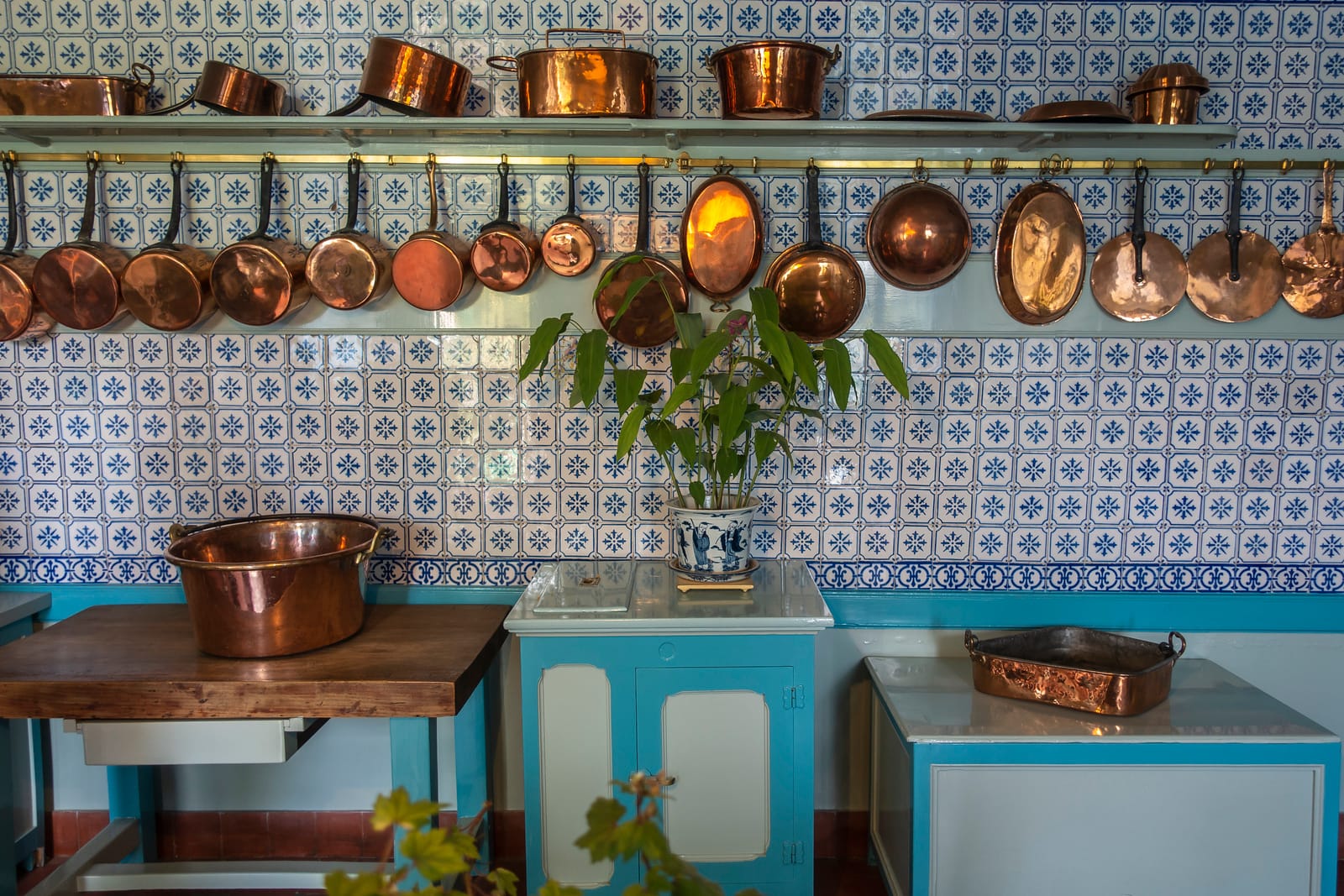
As you climb the creaky staircase, it's hard not to feel a sense of history in the air. Even though much of the house has been carefully restored, it still feels remarkably authentic - full of charm and character.
The 'little blue sitting room' and Monet's studio can feel a bit tight, especially with other visitors admiring the paintings and snapping photos. But there's something about the closeness and the dim lighting - used to protect the artwork - that creates a cosy, almost lived-in atmosphere. It's easy to imagine that house bustling with life, filled with the chatter and footsteps of Monet's large family - all eight children.
Monet's bedroom is another highlight. A large window looks out over the rose garden - it's one of the most photographed spots in the house. The walls are lined with reproductions of paintings by Monet himself, as well as by fellow impressionists like Renoir.
Downstairs, the bright yellow dining room is instantly uplifting. It's bald yet tasteful, and feels surprisingly modern for its time. The kitchen next door continues the theme - decorated with beautiful blue Rouen tiles, shelves lined with shining copper pots, and a big old stove tucked into the corner. A long wooden table sits at the centre, as if still waiting for the next family meal.
When you're ready to leave the house, head out through the kitchen door - and suddenly, you're in the garden. It's just as vibrant as the rooms inside. Take your time here. Slow down. Let the colours inspired you - just like they once inspired Monet.
Wandering Through Monet's Two Magical Gardens
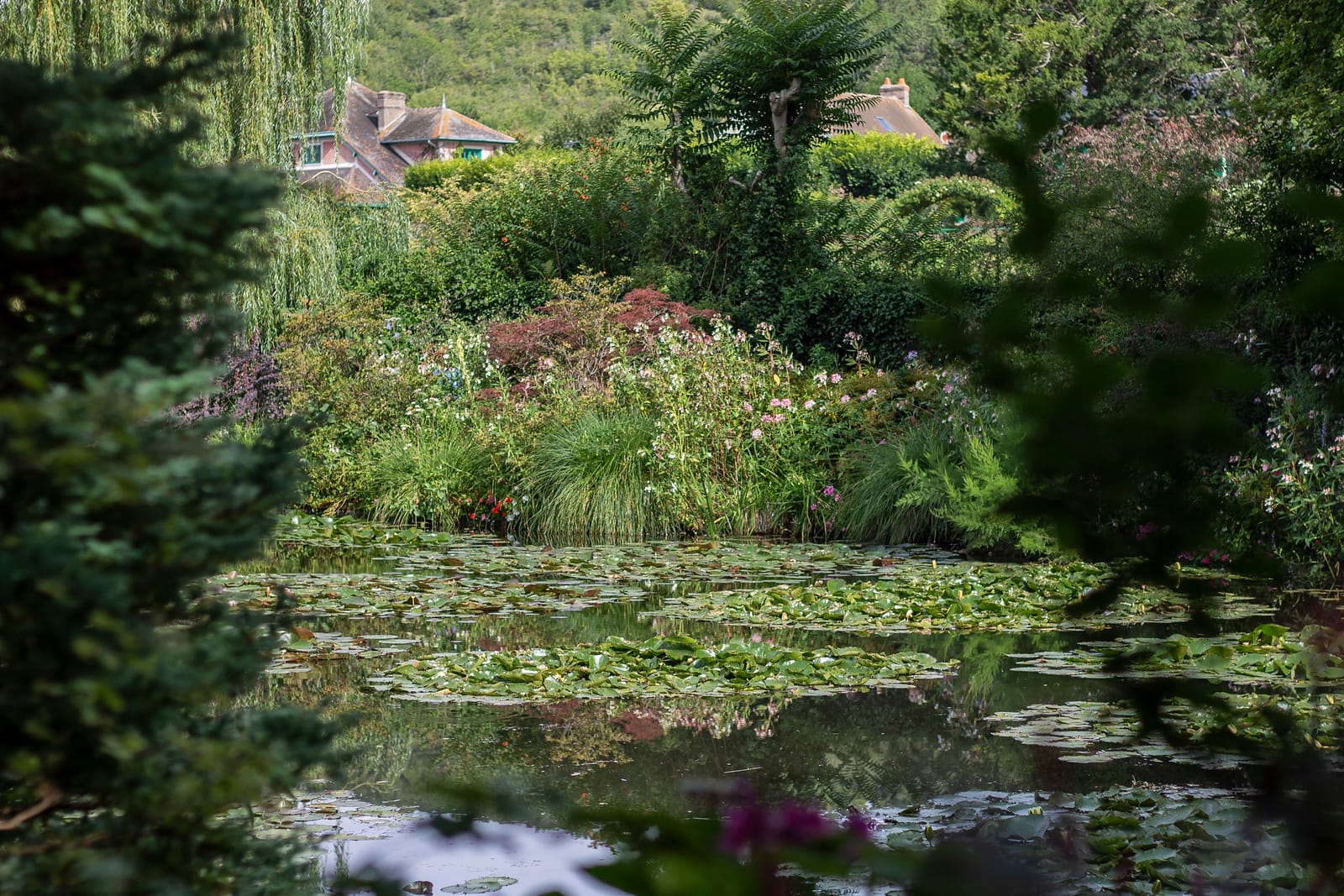
You'll first step into Clos Normand, the main flower garden in front of Monet's house, directly trough the kitchen door. It's a vibrant, changing showcase of Monet's gardening genius - packed with seasonal blooms that make it worth visiting throughout the season.
If you time your visit well, you'll catch specific flowers in bloom. Spring is especially lovely, with tulips, forget-me-nots, and daffodils brightening the garden in April. By May, the pathways come alive with clusters of pink rhododendrons and that iconic cascade of wisteria draped over the bridge.
July marks the beginning of the waterlily season, and by August, they're in full bloom - a dream for photographers. We were lucky enough to visit in late August, and the garden was still full of delicate roses, giving the whole space a soft, romantic feel.
Once you've wandered though Clos Normand, a short tunnel leads you across the road to the Water Garden - home to the world-famous Japanese bridge. While the current bridge is a replica, Monet himself planted the wisteria that still rustles gently above it.
The banks of the lily pond are shaded by whispering willow trees and walls of bamboo, creating a serene atmosphere. It's here you'll find Monet's legendary nymphéas - the water lilies that inspired over 250 of his most iconic paintings.
Is Monet's Garden Worth Visiting?
Absolutely - it's one of those places that really lives up to the hype.
Set in the charming village of Giverny, Monet's Garden is a must-see if you're exploring Normandy or looking for a day trip from Paris that offers something special.
This is the very garden that inspired some of Claude Monet's most famous paintings, including the iconic Water Lilies series. And when you're standing there, looking at the Japanese bridge or the shimmering pond, it's easy to see why he was so captivated by it.
Thanks to its meticulous upkeep, sheer variety of flowers, Monet's Garden remains one of the most visited - and most loved - destinations in France. And it's close enough to Paris to make it a comfortable day out.


